Wai-Fah Chen.The Civil Engineering Handbook
Подождите немного. Документ загружается.

49
-4
The Civil Engineering Handbook, Second Edition
a substantial proportion of perforated members. Storage installations range from relatively small shelving
systems to extremely large and sophisticated pallet racking systems.
Advantages of Cold-Formed Steel
Cold-formed steel products have several advantages over hot-rolled steel sections. The main attractions
of cold-formed steel sections are their lightness, high strength and stiffness, ease of fabrication and mass
production, fast and easy erection and installation, substantial elimination of delays due to weather, more
accurate detailing, nonshrinking and noncreeping at ambient temperatures, absence of formwork, pro-
tection from termites and rot, uniform quality, economy in transportation and handling, and noncom-
bustability. The combination of these advantages can result in cost savings during construction (Yu, 1991).
Design Codes and Specifications
Since the late 1970s cold-formed steel has taken on a new importance in Europe, and there has been a
period of substantial activity in research and in the development of new design codes. This began with
the publication of a new Swedish design specification in 1982 (National Swedish Committee on Regula-
tions for Steel Structures, 1982), followed by European recommendations at various stages. Insofar as
the design method is concerned, some specifications use the allowable stress design approach, whereas
others are based on a limit state design. The American Iron and Steel Institute (AISI) includes both
allowable stress design (ASD) and load and resistance factor design (LRFD). In the United Kingdom,
British Standard (BS) 5950, Part 5 (British Standards Institution, 1987), deals with the design of cold-
formed steel members. This code had some amendments added in 1996. Eurocode 3: “Design of Steel
Structures,” Part 1.3: “General Rules, Supplementary Rules for Cold-Formed Thin Gauge Members and
Sheeting,” was published as a European prestandard in 1996 and is having substantial and increasing
effect on cold-formed steel design throughout Europe. Both Canada (Canadian Standards Association,
1989) and Australia (Hancock, 1988) have developed their own codes, and in the United States a new
version of the AISI code was published in 1996.
New design codes have also been produced in the past few years to deal with some associated topics.
For example, stainless steel, dealt with by an ASCE specification in the U.S. (1990) was the subject of
another new European prestandard, Eurocode 3, Part 1.4: “General Rules, Supplementary Rules for
Stainless Steels,” in 1996, and this was followed by new South African (1997) and Australian (2001)
standards.
Range of Thicknesses
The provisions of codes apply primarily to steel sections with thickness not more than 0.33 in. (8 mm),
although the use of thicker material is not precluded. Minimum thicknesses for specific applications are
set by practical considerations, such as damage tolerance during handling, etc., and of course by the
economics of the particular applications. With regard to the maximum thickness, 0.33 in. (8 mm) is
about the limiting thickness normally rolled, although sections of up to about 0.8 in. (20 mm) can be
rolled for specific applications.
Properties of Steel
The design strength of the steel used should be taken as the yield strength of the material provided that
the steel has an ultimate tensile strength about 20% or more greater than the yield strength. To ensure
that, if this is not the case, the design strength is reduced accordingly in some codes. In the case of steels
that have no clearly defined yield strength, either the 0.2% proof stress or the stress at 0.5% total
elongation in a tensile test may be taken as the design strength. The yield points of steels listed in the
AISI specification range from 25 to 70 ksi (172 to 483 MPa).
The strength of members that fail by buckling is also a function of the modulus of elasticity E, the
value of which is recommended as 29,500 ksi (203 kN/mm
2
) by AISI in its specification for design
purposes. Poisson’s ratio is taken as 0.3.
© 2003 by CRC Press LLC
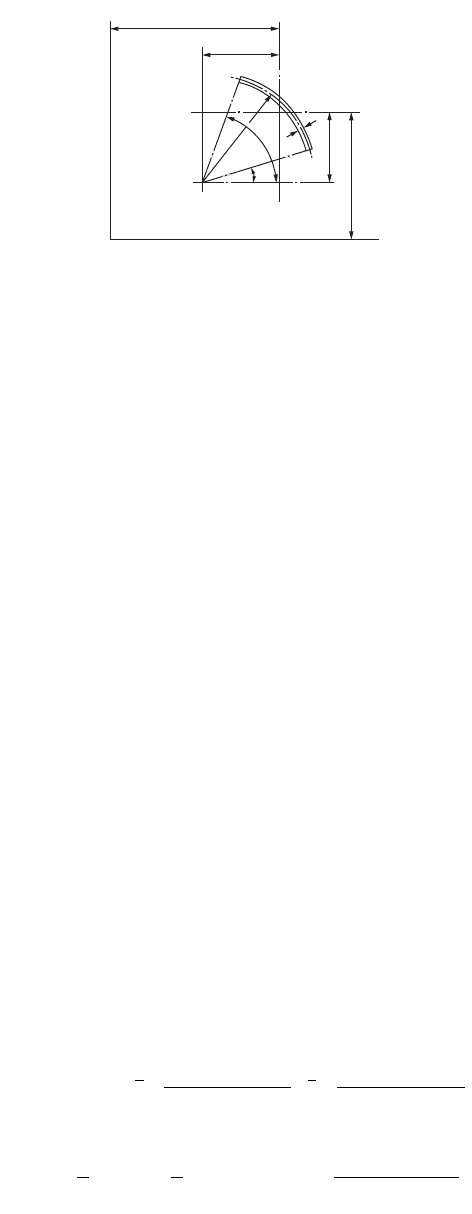
Cold Formed Steel Structures
49
-5
Effects of Cold Forming
Cold forming increases the yield and ultimate tensile strengths of the material being formed in the vicinity
of the bend areas. Experiments suggest that the average increase in yield strength of a section is dependent
on the number of bends, the area of the section, the material thickness, and the difference between the
ultimate and yield strengths of the material. Significant enhancement of the yield strength due to cold
forming is found only for sections composed largely of corners with small radii and having small width-
to-thickness ratios. For more slender cross-sections the benefits of cold forming on enhancement of yield
become substantially reduced. If a member is subjected to tension only, then it is quite permissible to
use the increased yield strength for the complete cross-section. If, however, the member is subjected to
compression or combinations of compression and bending, then each element should be considered
separately after the initial determination of the average yield strength of a formed section. In determi-
nation of the compression yield strength of an individual element the width-to-thickness ratio of the
element is important. Since there is no conclusive evidence to support the design use of enhanced yield
strength in the presence of local buckling, which occurs for slender elements, enhancement of the yield
strength due to cold forming should not be taken into account for slender elements subject to local
buckling behavior.
Since any operation on the formed material that introduces heat, such as welding, annealing, galva-
nizing, etc., will affect the material properties, the use of the enhanced yield strength is prohibited if any
such operation is carried out.
Calculation of Section Properties
Since many cold-formed steel sections have thin walls and small radii, the determination of section
properties in many cases can be simplified by assuming that the material is concentrated at the centerline
of the section and the area of elements are replaced by straight or curved “line elements.” The thickness
dimension t is introduced after the linear computations have been completed.
Properties of Corners
For a corner element of the geometry shown in Fig. 49.4 the properties are as follows, with the angles
given in radian measure:
(49.1)
(49.2)
FIGURE 49.4
Geometry of a corner.
X
X
Y
x
t
R
x
y
Y
x
−
y
Y
−
y
−
θ
1
θ
2
x
−
ARt x
R
y
R
=-
()
=
-
()
-
()
=
-
()
-
()
qq
qq
qq
qq
qq
21
21
21
12
21
,
sin sin
,
cos cos
IRt
xx
=-
()
--
()
-
-
()
-
()
Ï
Ì
Ô
Ó
Ô
¸
˝
Ô
˛
Ô
3
21 2 1
12
2
21
1
2
1
4
22qq q q
qq
qq
sin sin
cos cos
© 2003 by CRC Press LLC

49
-6
The Civil Engineering Handbook, Second Edition
(49.3)
(49.4)
In the particular case of a right angled corner with
q
1
= 0 and
q
2
=
p
/4 the properties may be written as follows:
(49.5)
(49.6)
(49.7)
Formulas for the bending properties of a number of common cross-sections, based on centerline dimen-
sions, are given in Table 49.1.
Effects of Holes
In evaluation of the section properties of members in bending or compression, holes made specifically
for fasteners such as screws, bolts, etc. may be neglected on the basis that the hole is filled with materials
in any case. However, for any other openings or holes the reduction in cross-sectional area and cross-
sectional properties caused by these holes or openings should be taken into account. If the section
properties are to be evaluated analytically they should be calculated considering the net cross-section
that has the most detrimental arrangement of holes that are not specifically for fasteners. This is not
necessarily the same cross-section for bending analysis and compression analysis. This is illustrated in
Fig. 49.5, where for the channel section shown the net cross-section A-A has a smaller area than cross-
section B-B and is therefore critical with regard to purely compressional behavior. The second moment
of area about x-x and minimum section modulus of cross-section B-B with regard to axis, however, are
less than those of section A-A, and for bending strength section B-B is critical.
In the case of tension members, fasteners do not themselves effectively resist the tension loading, which
is tending to open the fastener holes; holes made for fasteners must also be taken into consideration for
tension loading. In determining the net area of a tension member, the cross-section that has the largest
area of holes should be considered. The area that should be deducted from the gross cross-sectional area
is the total cross-sectional areas of all holes in the cross section. In deducting the area of fastener holes
the nominal hole diameter should be used. In the case of countersunk holes the countersunk area should
also be deducted. In a tension member that has staggered holes, the weakening effects of holes that are
not in the same cross-section, but close enough to interact with the holes in a given cross-section, should
be taken into account. If two lines of holes are far apart, then one line of holes does not have any effect
on the strength of the section at the position of the other line of holes. If the lines are close, however,
then each line of holes affects the other.
49.2 Local Buckling of Plate Elements
A major advantage of cold-formed steel sections over hot-rolled sections is to be found in the relative
thinness of the material from which the sections are often formed. This can lead to highly efficient and
IRt
yy
=-
()
+-
()
-
-
()
-
()
Ï
Ì
Ô
Ó
Ô
¸
˝
Ô
˛
Ô
3
21 2 1
21
2
21
1
2
1
4
22qq q q
qq
qq
sin sin
sin sin
IRt
xy
=-
()
-
+
()
-+
()
-
()
Ï
Ì
Ô
Ó
Ô
¸
˝
Ô
˛
Ô
3
12
12 1 2
21
1
4
22
1
2
22
cos cos
sin sin sin
qq
qq q q
qq
A
Rt
Rt y
R
Rx
R
R== == ==
p
pp2
157
2
0 637
2
0 637., . , .
IIRt Rt
xx yy
== -
Ê
Ë
Á
ˆ
¯
˜
=
33
4
2
0 149
p
p
.
IRt Rt
xy
=-
Ê
Ë
Á
ˆ
¯
˜
=-
33
1
2
2
0 137
p
.
© 2003 by CRC Press LLC
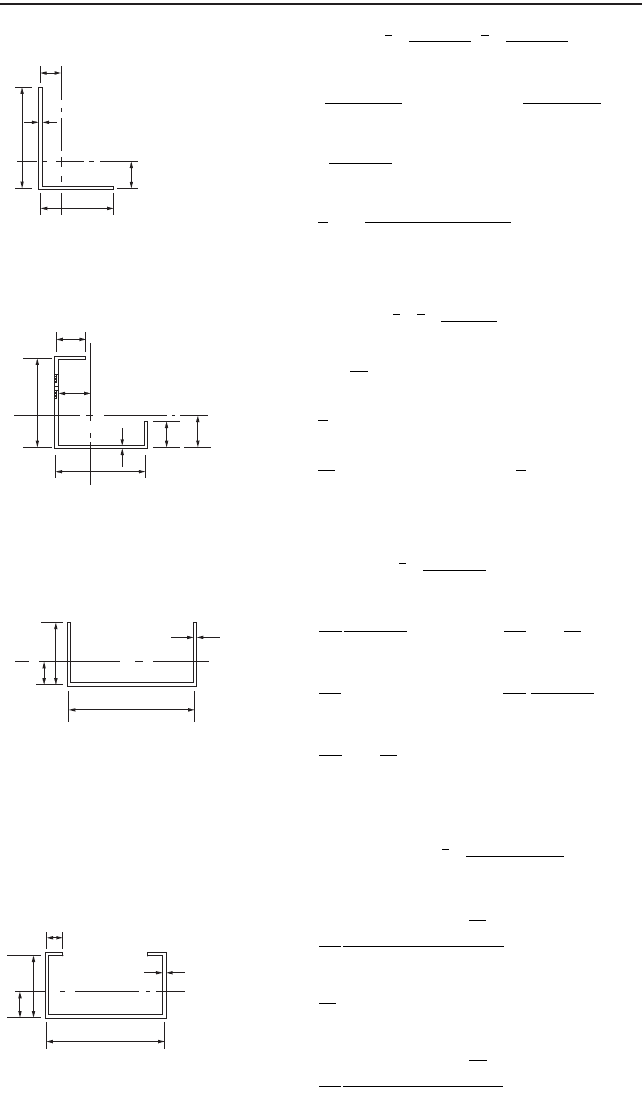
Cold Formed Steel Structures
49
-7
TA BLE 49.1
Formulas for Bending Properties of Typical Sections
b
1
b
2
x
t
x
y
y
y
−
x
−
Unequal angle
Atb b y
b
2b b
x
b
2b b
It
bb 4b
12 b b
I t
b4b b
12 b b
I
tb b
4b b
y
1
2
tan
6b b
b
22
1
2
12
2
2
12
xx
1
1
12
12
yy
2
5
12
12
xy
1
2
2
2
12
2
1
2
2
2
1
=+
()
=
-
()
=
+
()
=
+
()
+
()
=
+
()
+
()
=-
-
()
=
-
44
1
3
212
2
2
4
4b b 4b b b+--
b
1
b
1
b
2
b
2
x
t
x
y
Lipped angle
y
y
−
x
−
A2b b yx
bb
4
II
t
24
5b 5b 15b b 5b b
I
t
8
5b b bb3bb
I
t
12
bb I
t
3
2b b b
12
12
xx yy 1
2
2
3
1
2
212
2
xy 2 2
2
1
3
2
3
1
2
2
xx 1 2
2
yy 1
3
12
3
=+
()
==
+
()
== + + -
()
=---
()
=+
()
=--
()
Ê
Ë
ˆ
¯
b
1
b
2
t
xx
y
−
Plain channel
Atb 2b y
b
2b b
I
tb
3
2b b
b2b
I
tb
12
16
b
b
z
tb
3
2b b z
tb
3
2b b
bb
z
tb
6
16
b
b
12
2
2
12
xx
2
3
12
12
xy
1
3
2
1
x1
3
12 x2
3
2
32
12
y
1
2
2
1
=+
()
=
+
()
=
+
()
+
()
=+
Ê
Ë
Á
ˆ
¯
˜
=+
()
=
+
()
+
()
=+
Ê
ËË
Á
ˆ
¯
˜
y
−
Lipped channel
xx
b
2
b
3
b
1
t
Atb 2b 2b y
bb 2b
b2b2b
I
bt
3
b4bb26
b
b
b2b2b
I
t
12
2b 6b b b 2b
z
bt
123
22 3
123
xx
2
3
231
3
2
123
yy 1
3
21
2
13
3
x1
2
1
=++
()
=
+
()
++
()
=
++ +
Ê
Ë
Á
ˆ
¯
˜
Ê
Ë
Á
ˆ
¯
˜
++
()
=+--
()
È
Î
Í
˘
˚
˙
=
33
b4bb26
b
b
2b b
231
3
2
12
++ +
Ê
Ë
Á
ˆ
¯
˜
È
Î
Í
Í
˘
˚
˙
˙
+
()
© 2003 by CRC Press LLC
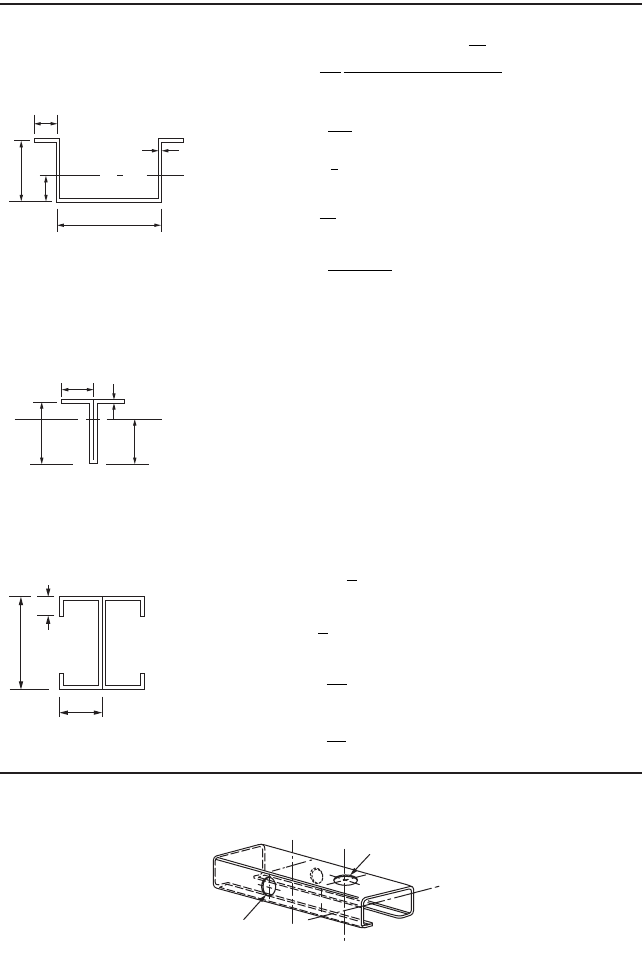
49
-8
The Civil Engineering Handbook, Second Edition
weight-effective members and structures. However, the potential advantages of the thin walls can be only
partially obtained, and to obtain these advantages the designer must be aware of the phenomena asso-
ciated with thin-walled members and their effects on design analysis. Perhaps the most important of
these phenomena is
local buckling
.
Use Top Hat equations with b
1
= 0
‘
FIGURE 49.5
Channel section with holes.
TA BLE 49.1 (continued)
Formulas for Bending Properties of Typical Sections
xx
y
−
Top hat section
b
2
b
3
b
1
t
z
bt
3
b4bb26
b
b
bb
z2
x
b
For A, y, I , z , z see lipid channel
I
5
12
b2b 6bb
Z2
t
b2b
x2
2
2
231
3
1
12
y
yy
1
xx x1 z1
yy 2 3
3
1
2
2
y
yy
23
=
++ +
Ê
Ë
Á
ˆ
¯
˜
È
Î
Í
Í
˘
˚
˙
˙
+
()
=
=+
()
+
È
Î
Í
˘
˚
˙
=
-
()
Tee section
t
b
3
b
2
xx
y
−
b
1
b
3
b
2
I Section
A2tb 2b 2b
1bt
2
3
b4b
I
1
6
2b 6b b b 2b
z2
I
b
z2
I
b
123
yy 2
2
23
xx 1
3
21
2
13
3
x
xx
1
y
yy
2
=++
()
=+
Ê
Ë
Á
ˆ
¯
˜
=+--
()
È
Î
Í
˘
˚
˙
=
=
One hole
diameter ‘D’
each side
X
X
One hole
diameter ‘D’
B
B
A
A
© 2003 by CRC Press LLC
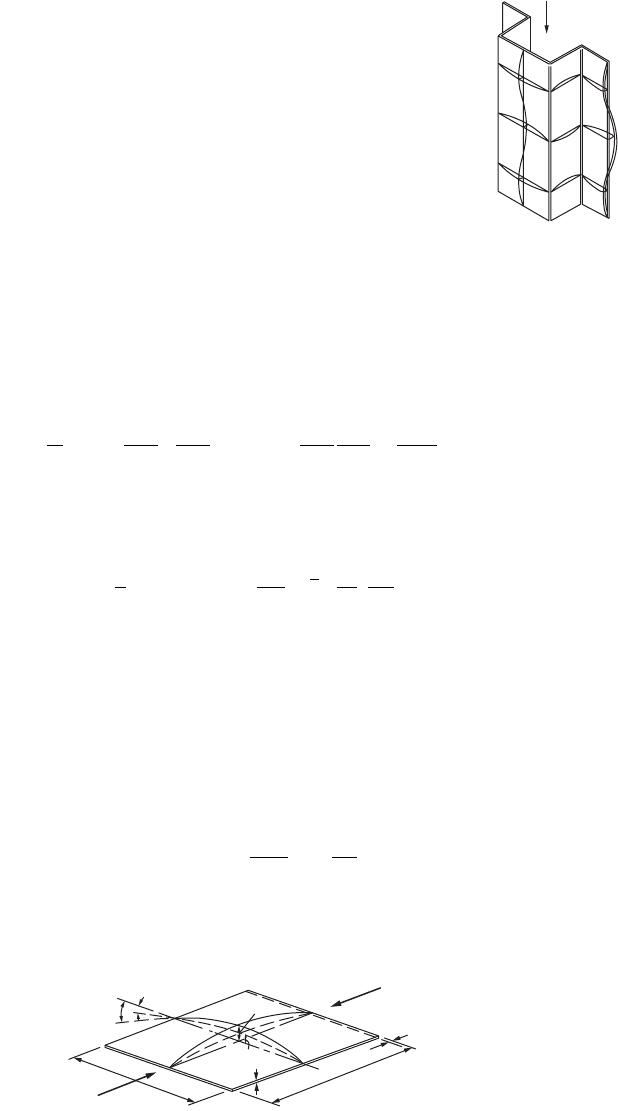
Cold Formed Steel Structures
49
-9
Local Buckling of Plates
When a thin plate is loaded in compression the possibility of local buckling
arises. This type of buckling is so called because the length of buckles that
form is similar to the dimensions of the cross-section rather than the length
of the structure, as is normally the case with other types of buckling. Elastic
local buckling in a member is characterized by a number of ripples, or
buckles, becoming evident in the component plates, as illustrated in Fig.
49.6. This local buckling has substantial bearing on the stiffness and strength
of the member, and to gain some insight into the local buckling phenome-
non, we shall now examine local buckling of plate elements.
Local Buckling Analysis
Consider the plate shown in Fig. 49.7, supported on all four edges and
compressed uniformly on its longitudinal edges to produce a displacement
u, as shown in the figure. Due to the loading we shall assume that out-of-
plane deflections w occur as shown. We can examine the local buckling situation from a consideration
of the strain energy in the plate. The strain energy due to bending U
B
can be written in terms of the
deflections as
(49.8a)
The strain energy in the plate due to the membrane actions is given by
(49.8b)
where
–
e
= the “nominal” applied strain, equal to u/a
E = the modulus of elasticity
The total strain energy stored in the plate is given by the sum of bending and membrane energies.
Since the displacement of the plate ends is prescribed, the principle of minimum potential energy requires
that the strain energy is a minimum. The simplest case of local buckling, very often considered in design,
is that of a plate simply supported on all four edges. In this case the deflections w at buckling are given
by the expression
(49.9)
in which n indicates the number of half-sine waves into which the plate buckles in the x direction.
Substituting for w in U (= U
–D
+ U
B
) and performing the integrations gives the strain energy in terms
FIGURE 49.7
Uniformly compressed plates.
FIGURE 49.6 Local buck-
ling in a thin-walled section.
U
Dw
x
w
y
w
x
w
y
w
xy
dxdy
B
area
=+
Ê
Ë
Á
ˆ
¯
˜
--
()
-
Ê
Ë
Á
ˆ
¯
˜
È
Î
Í
Í
˘
˚
˙
˙
Ï
Ì
Ô
Ó
Ô
¸
˝
Ô
˛
Ô
ÚÚ
2
21
2
2
2
2
2
2
2
2
2
2
d
d
d
d
n
d
d
d
d
d
dd
Updvol
Eta
a
w
x
dy
Dxx
vol
=
()
=-
∂
∂
Ê
Ë
Á
ˆ
¯
˜
Ê
Ë
Á
ˆ
¯
˜
ÚÚ
1
22
1
2
2
2
ee
ww
nx
a
y
b
c
=
Ê
Ë
Á
ˆ
¯
˜
sin sin
pp
t
P
P
w
w
o
b
u = ε.e.b.
a = eb
θ
o
θ
© 2003 by CRC Press LLC

49
-10
The Civil Engineering Handbook, Second Edition
of the deflection magnitude coefficient w
c
. Using the principle of minimum potential energy it can be
shown that the critical stress (p
cr
) to cause local buckling is given as
(49.10)
The coefficient K is called the buckling coefficient and, for the case in question, is given by
(49.11)
The variation of K with the variation in the plate length-to-width ratio a/b is shown in Fig. 49.8 for
various numbers of buckles n. As may be observed from this figure, the minimum value of K is 4; this
occurs when the length of the plate is equal to n times the plate width. For long plates, the number of
buckle half-waves that occur is approximately the same as the ratio of the plate’s length to its width, and
the buckling coefficient is very close to 4. For plates with different support conditions the value of the
buckling coefficient becomes different from 4.
Thus the value of the stress required theoretically to produce local buckling varies inversely as the
square of the plate width-to-thickness ratio. Plates with lower width-to-thickness ratios will theoretically
yield before local buckling, and plates with higher width-to-thickness ratios will buckle before yielding.
This statement holds true only for perfect plates. In the practical situation imperfections are always
present, and the effects of local buckling are generally to be observed at stresses less than the theoretical
buckling stress. Furthermore, local buckling does not necessarily signify the attainment of the full load
capacity of a plate. For very thin plates, local buckling occurs at low stress levels and such plates can
sustain loads greatly in excess of the buckling load. It is this capacity to carry loads beyond the local
buckling load that provides the means for advantageous use of thin plates, but also requires knowledge
of the adverse effects of local buckling to ensure safe design.
Postbuckling Analysis
If the plate has buckled, the magnitude of the local buckles is related to the compression magnitude. The
variation of stresses with the variation in strains after buckling can be shown to be
(49.12)
Thus the average stress varies across the plate as indicated in Fig. 49.9. Strips of plate near the supports
are relatively unaffected by local buckling and carry increased loading as further compression is applied,
while strips of plate near the center shed the load and offer very little resistance to further compression.
The plate may be thought of as consisting of a series of slender columns linked together, with those near
FIGURE 49.8
Var iation of buckling coefficient with length for a simply supported plate.
10
K
6012345
2
4
6
8
n = 1n = 2n = 3n = 4n = 5n = 6
a/b
pE
D
bt
nb
a
a
nb
KE
t
b
cr cr
== +
È
Î
Í
˘
˚
˙
=
-
()
Ê
Ë
Á
ˆ
¯
˜
e
pp
n
2
2
2
2
2
2
12 1
K
nb
a
a
nb
=+
È
Î
Í
˘
˚
˙
2
pE
y
b
xcr
=--
()
È
Î
Í
˘
˚
˙
eee
p
4
3
2
sin
© 2003 by CRC Press LLC
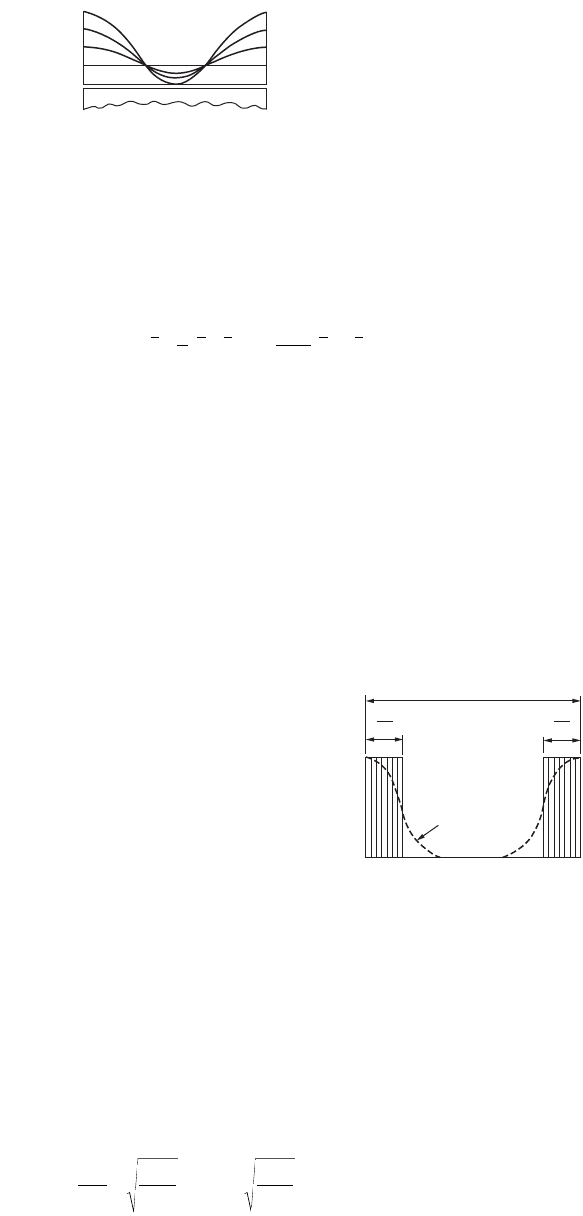
Cold Formed Steel Structures 49-11
the edges largely prevented from buckling and those near the center buckling relatively freely. The plate
does not behave completely like a column and lose all its compression resistance after local buckling, but
its resistance after buckling is confined to portions of the plate near the supported edges.
The load on the plate at any end compression is obtained by summing the stresses across the plate, i.e.,
(49.13)
The plate load grows after buckling with increasing compression, but the rate of growth is substantially
reduced relative to that before buckling.
The analysis shows that after buckling the plate stiffness reduces, the edge stresses increase more quickly
with the load than before buckling, and the plate center becomes inefficient at resisting the load, witnessed
by the load shedding in this area. The plating could only be considered effective in resisting compression
over a short width adjacent to the supports. As a rule of thumb, in ship design it was considered that a
width of plate equal to 25 times the thickness could be considered to effectively resist compression adjacent
to each support. Thus for a plate with supports on each edge a total width of 50t was considered to be
effective in resisting compression. This was the origin of the effective width concept, now used widely
in design analysis.
The Effective Width Concept
The effective width concept, as generally used in design, assumes that
the portions of a plate element near the supports are fully effective in
resisting load and the remainder of the element is completely ineffective.
This is illustrated in Fig. 49.10, in which the varying stress distribution
across an element is idealized into a constant stress acting over the two
effective portions and the center part of the plate is considered com-
pletely ineffective and stress-free.
In 1932 von Karman et al. produced the first theoretical explanation
of the effective width concept, and in the years that followed many
investigators produced further insight into this field. At the present time
there is a variety of methods available for rigorous analysis of plates
under many conditions of loading and support, ranging from
approaches that have been set up for relatively easy use by the reader to the numerical approaches using
finite elements or finite differences.
Research into cold-formed steel began largely in the U.S., and much of the original work was carried
out at Cornell University, Ithaca, New York by George Winter. In dealing with local buckling, Winter
(1947) produced an empirical variation of the von Karman effective width expression that, with minor
modifications, has been accepted in the U.S. and in many other countries for analysis of local buckling.
This expression, in the form widely used at the present time, is as follows
(49.14)
FIGURE 49.9 Variation of stress across a plate after local buckling.
4p
cr
3p
cr
2p
cr
p
cr
ptpdyEtb
Etb
xcrcr
==--
()
È
Î
Í
˘
˚
˙
=+
[]
Ú
eee ee
2
33
2
FIGURE 49.10 Effective width
idealization.
b
2
e
b
2
e
b
Actual stress
distribution
b
b
p
p
p
p
eff cr cr
=-
Ê
Ë
Á
ˆ
¯
˜
max max
.1022
© 2003 by CRC Press LLC
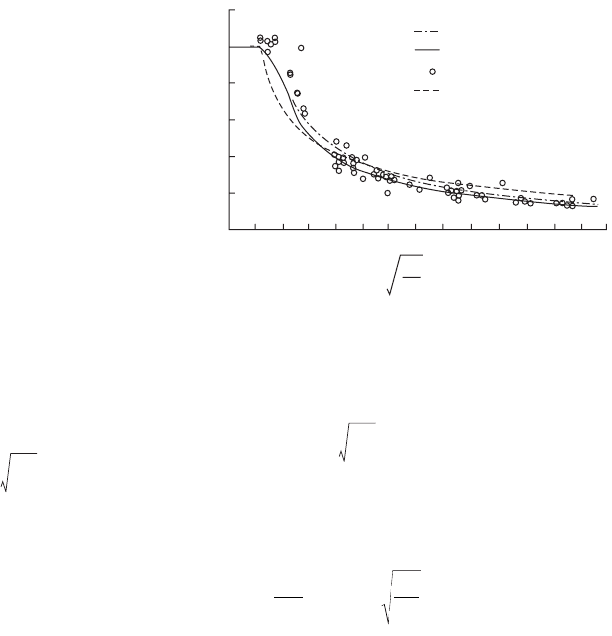
49-12 The Civil Engineering Handbook, Second Edition
in which p
max
= the maximum edge stress in the plate
b
eff
= the effective width of the compression element
As per AISI recommendation, b
eff
= b for < 0.673, and the b
eff
is calculated from Eq. (49.14) for
> 0.673.
The basic effective width expression developed for BS 5950, Part 5 (British Standards Institution,1987),
is as follows:
(49.15)
in which f
c
is the edge stress corresponding to the yield stress when failure is said to occur.
This expression is a little more cumbersome than that of Eq. (49.14), but still perfectly usable on a
calculator or a small microcomputer.
Figure 49.11 shows comparison of the basic effective width expression (Eq. (49.15)) with the AISI
expression (Eq. (49.14)), the CL factors of addendum 1 (British Standards Institution, 1975) to BS 449,
and experiments from various sources. The experiments shown here are all on simply supported plates,
and even so, a significant degree of scatter is noticeable.
Classification of Elements
In using the effective width approach to deal with elements of sections, the different types of element
used in such sections need to be taken into consideration. These may be classified into four groups:
stiffened elements, unstiffened elements, edge-stiffened elements, and intermediately stiffened elements.
Examples of each type of element are shown in Fig. 49.12.
Stiffened elements are elements that are supported (or stiffened) by having a substantial element on
both longitudinal edges. If the supporting elements are themselves stiffened, or edge stiffened, elements,
then this type of element can have a width-to-thickness ratio of up to 500. For such an element the
minimum K factor applied is 4.
Unstiffened elements are elements that are supported along only one longitudinal edge. In this case
local buckling arises much more quickly than it does for stiffened elements, and because of this, the
width-to-thickness ratio that can be covered by the code is considerably reduced. The relevant maximum
width-to-thickness ratio is 60, and the minimum K factor is 0.425.
Since unstiffened elements are severely affected by local buckling, it is common practice to convert
these into stiffened elements by folding the free edge of these elements to produce a lip, or a similar edge
FIGURE 49.11 Effective widths from design codes and tests from various sources.
1.2
1
0.8
0.6
0.4
0.2
0
beff/b
0 0.5 1 1.5 2 2.5 3 3.5 4 4.5 5 5.5 6 6.5 7
AISI specification
BS 5950 : Pt 5
Experiments
BS 449 Addendum No 1
Y
s
p
cr
p
max
p
cr
----------
p
max
p
cr
----------
b
b
f
p
eff c
cr
=+ -
Ê
Ë
Á
ˆ
¯
˜
È
Î
Í
Í
˘
˚
˙
˙
-
114 035
4
02
.
.
© 2003 by CRC Press LLC
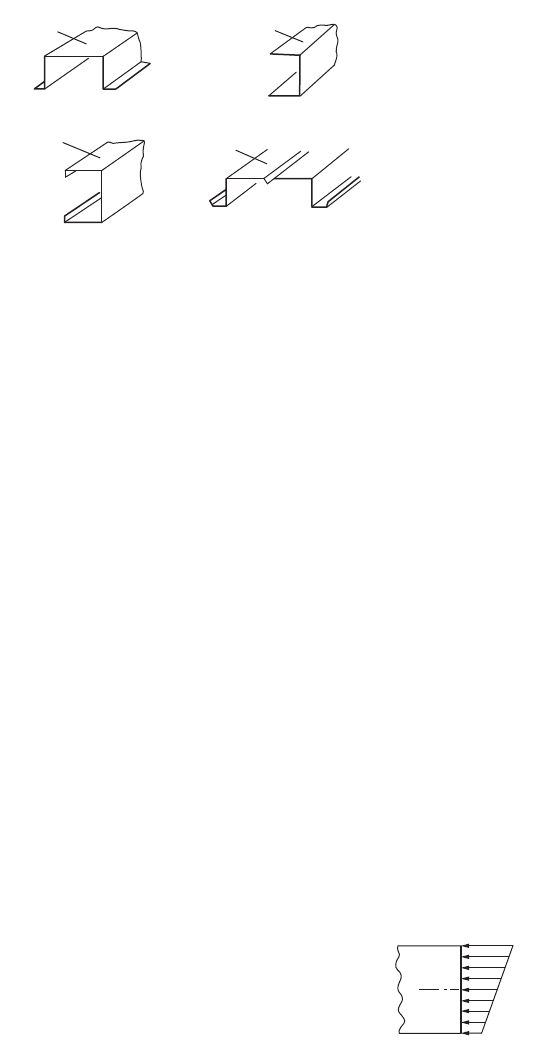
Cold Formed Steel Structures 49-13
stiffener, to support this edge and prevent local buckling of the edge. If the edge stiffener satisfies the
requirements of the code, then such an element may be treated as a stiffened element. For such an edge-
stiffened element, however, the maximum width-to-thickness ratios are severely curtailed by the codes.
In the case of an element stiffened by a simple lip, the maximum allowable width-to-thickness ratio is
60, while if any other type of edge stiffener is used, the width-to-thickness ratio can be increased to 90.
In order to improve the behavior of stiffened elements, intermediate stiffeners are often employed.
This type of stiffener is usually formed during the rolling process and has the effect of transforming a
slender, high b/t ratio element into two or more relatively compact subelements. This can substantially
increase the effectiveness of the element. The total width of intermediately stiffened elements is limited to
500 times the material thickness.
Stiffened Elements
Buckling Coefficients
Stiffened elements under uniform compression are considered to be governed by effective width expres-
sion. The minimum K factor used for such elements is 4, but if higher values can be justified, then these
may be used. The K factors applicable to compact elements, low b/t, can be much less than those for
slender elements in the same section. In general, the elements in a section that are restrained from
buckling at their natural stress induce premature buckling in the elements that restrain them, and if one
element has a buckling coefficient greater than 4, others will have buckling coefficients less than 4. This
mathematically correct, but rather pessimistic, view has been incorporated in some design codes, and
invariably leads to lower design loads than would occur if all elements were considered simply supported.
However, it has been observed (Rhodes, 1987) that for restraining elements the effects of premature
local buckling are negligible. Only when the applied loading is sufficient to attain the natural (simply
supported) buckling stress of such elements do these elements suffer the effects of local buckling to any
substantial degree.
Stiffened Elements under Eccentric Compression
For some stiffened elements, such as webs of beams, the loading is not
pure compression, but some combination of axial loading and in-plane
bending. In cases where this type of loading occurs the codes treat the
situation in one of two ways, depending on the degree of bending
involved. For beam webs in which the stress changes from compression
to tension across the element, the effective width approach is replaced by
a limiting stress approach.
For cases in which an element is subjected to a combination of com-
pression and in-plane bending in which the stress is compressive on both unloaded edges, sufficiently
accurate analysis may be obtained as follows. If the stress varies from f
c1
at one edge to f
c2
at the other
edge, as illustrated in Fig. 49.13, then the mean value of these stresses should be taken as the stress on
FIGURE 49.12 Types of elements found in cold-formed sections.
Stiffened
element
(a)
(b)
(d)
(c)
Unstiffened
element
Intermediately
stiffened element
Edge stiffened
element
FIGURE 49.13 Element with
varying stress distribution.
−f
c1
−f
c2
−f
cm
© 2003 by CRC Press LLC
